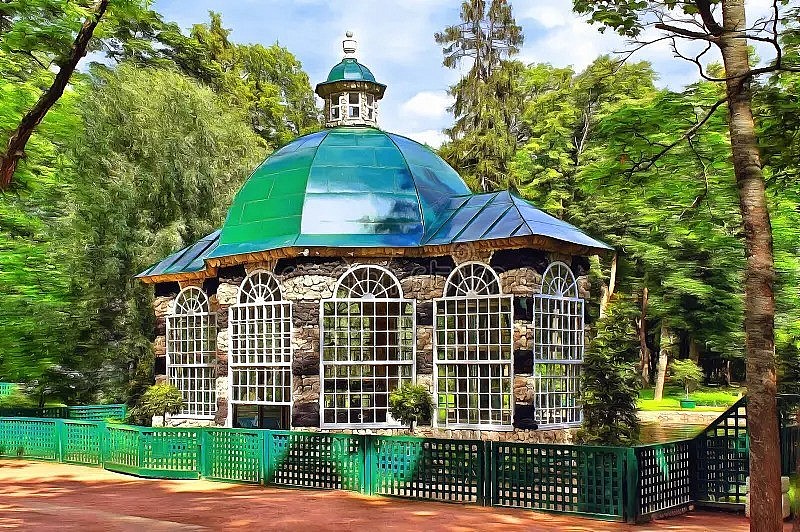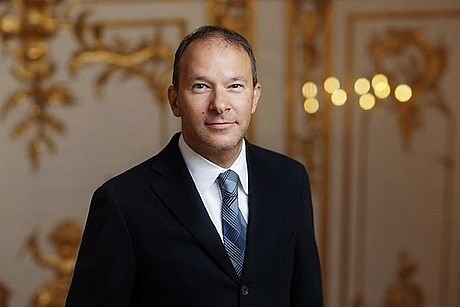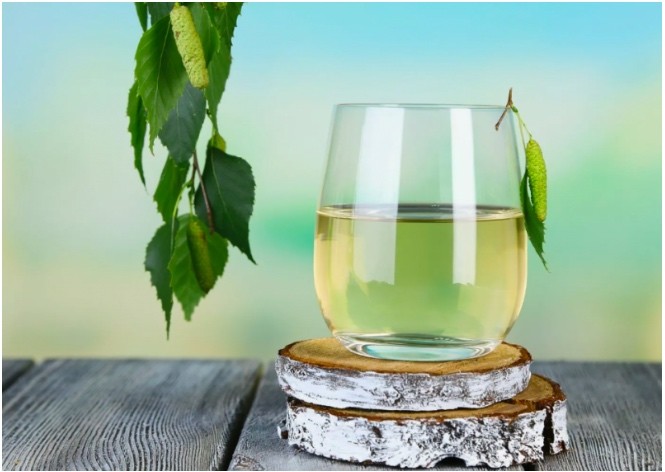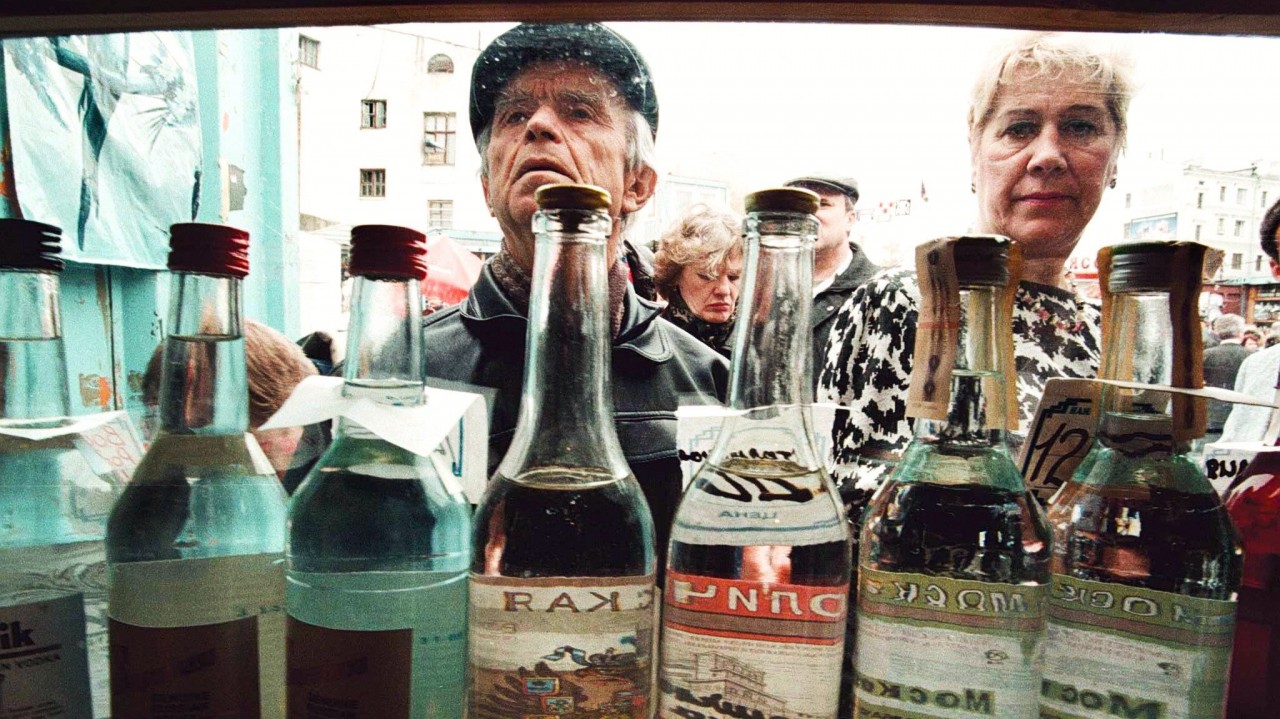Peterhof Summer Palace: From Luxury Resort to Historical Museum
| Winter Palace - Architectural and Historical Masterpiece | |
| Vodka: The National Drink of Russia |
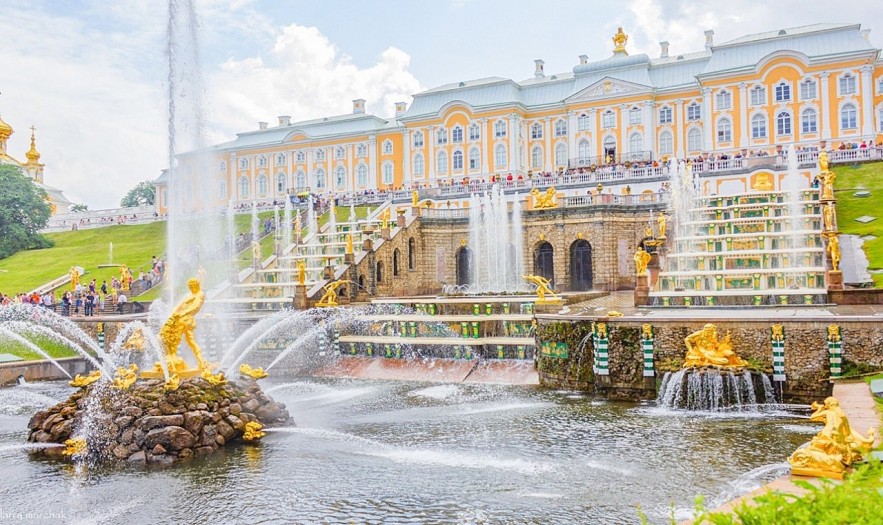 |
| Peterhof Summer Palace. |
City of Fountains
Peterhof Summer Palace is a series of palaces and gardens located on the shores of the Gulf of Finland, about 30km west of Saint Petersburg (Russia). It stands out with its perfect combination of Baroque and classical architecture. Viewed from a distance, the vast complex spanning over 800 hectares resembles a stunning painting, adorned with towers, domes, and facades that are gilded in dazzling gold, gleaming under the sunlight.
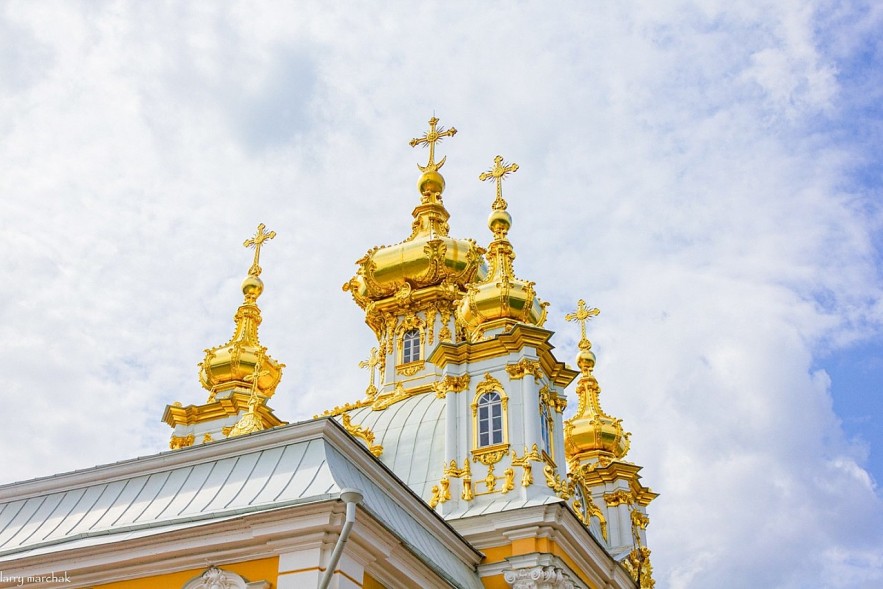 |
| Gilded details on the exterior of the Palace. (Photo: Larry Marchak) |
Peterhof Palace, known as the "City of Fountains," is renowned for its Grand Cascade system, which includes 64 fountains and 255 gilded statues. It is further embellished with reliefs, vases, and sculptures depicting dolphins and lions, adding to its unique and artistic atmosphere. This fountain complex is considered among the most luxurious in the world.
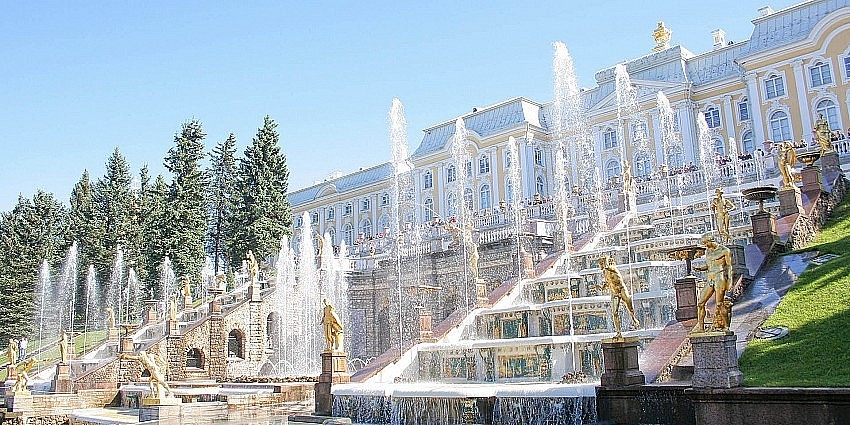 |
| The Grand Cascade has 64 fountains and 255 gilded statues. |
Annually, as May arrives, the fountains are activated and remain open for the duration of the summer. Peterhof's fountains function without the use of pumps, utilizing gravity to channel water from the Rospha stream located 22 kilometers away. Countless streams of water burst forth from the statues of ancient Greek deities, ascending skyward to create towering white columns, before cascading down the seven tiers of stairs, contributing to the site's grandeur and majestic allure.
The statue of Samson, a renowned figure in the Bible known for his immense strength, stands prominently at the center of the Grand Cascade, with the tallest water column reaching up to 20 meters. Historical records indicate that the statue depicts Samson courageously ripping open the lion's mouth, symbolizing Peter the Great's triumph over Sweden in the Battle of Poltava in 1709.
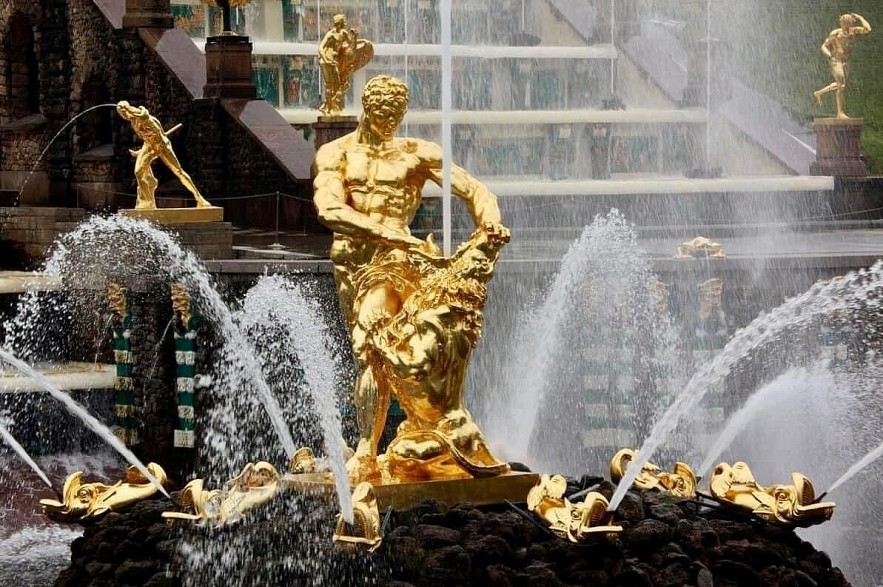 |
| The sculpture depicting Samson tearing open the lion's mouth stands at the heart of the Grand Cascade. |
Beyond the Grand Cascade, the Upper and Lower Gardens of the Summer Palace feature a variety of fountains and sculptures. Notably, the cracker fountains, a delight of 18th-century aristocracy, are hidden as clusters of flowers and trees, surprising passersby with sudden sprays of water. Moreover, should you decide to relax on a park bench, anticipate a playful surprise, as the bench might be yet another mischievous fountain.
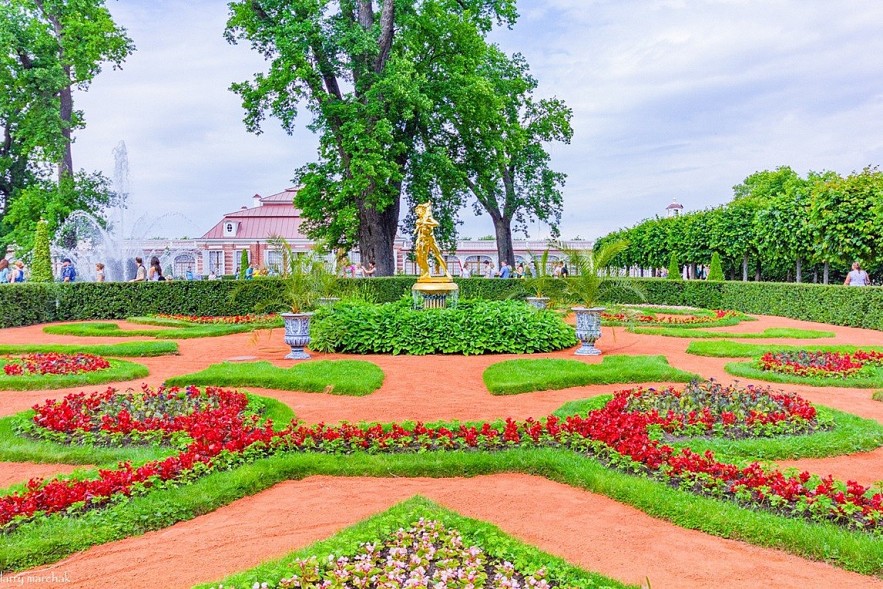 |
| In the garden, clusters of flowers, trees, and stone benches can all serve as fountains. (Photo: Larry Marchak) |
Where art and history meet
Located behind the fountain area, the Grand Palace (Royal Palace) serves as the centerpiece of the Peterhof complex. The palace spans two floors, comprising 14 rooms, two kitchens, and two internal corridors. The ground floor houses Emperor Peter I's room, and the upper floor is dedicated to his wife, Empress Catherine.
Each room has its own style and theme. Precious materials such as marble, marble from Italy, or rare wood from Russian forests are used in the interior decoration.
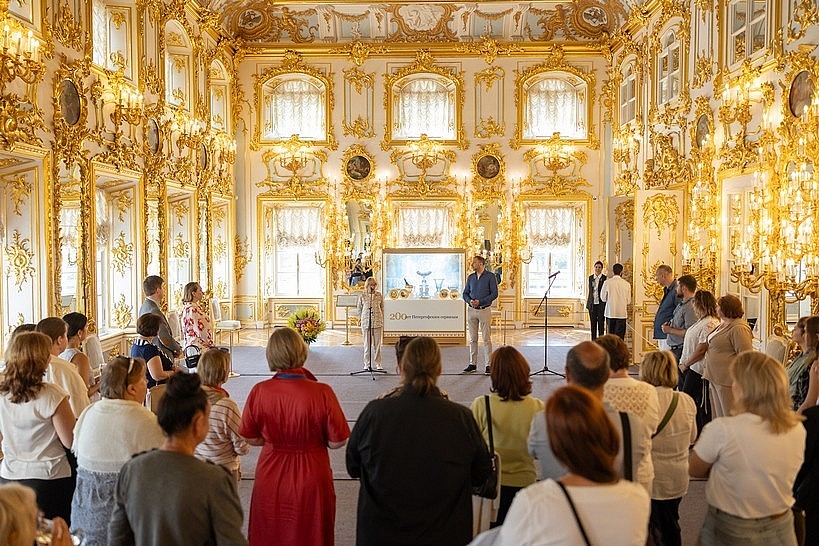 |
| The Peterhof Summer Palace's interior is adorned with opulent royal hues. (Photo: peterhofmuseum.ru) |
Ceremonial spaces, including the Throne Room and State Rooms, boast lavish decorations with walls and ceilings adorned in exquisite silk, detailed carvings, and gilding. The Chesma Hall, the palace's most distinguished room, celebrates the Russian triumph at the 1770 Battle of Chesma, where the Russian navy overcame the Ottoman fleet during the Russo-Turkish War (1768–1774). The numerous paintings that intricately depict this battle have come to symbolize the might and splendor of the Russian Empire in the 18th century.
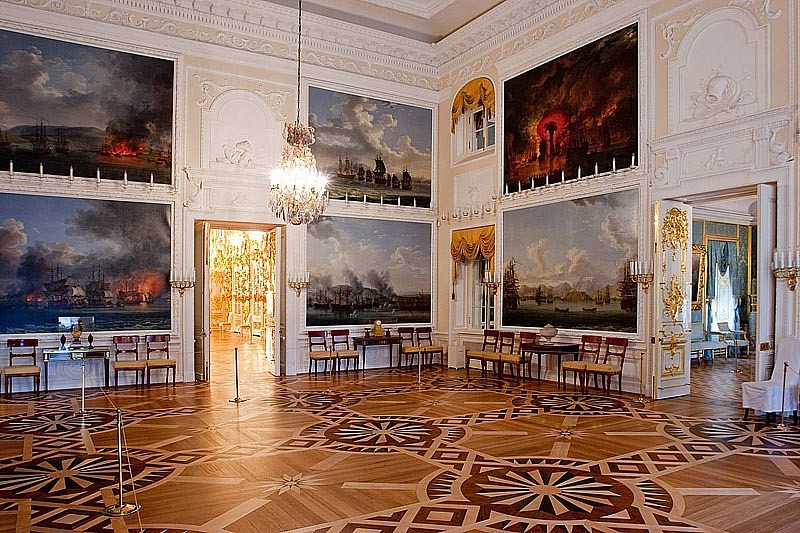 |
| The Chesma Room exhibits numerous paintings that celebrate the Russian triumph in the Battle of Chesma of 1770. (Photo: saint-petersburg.com) |
The Amber Room is renowned for its extensive library, which houses a multitude of books and artifacts amassed by Emperor Peter I. Its centerpiece is the anatomical collection of the Dutch scientist Frederik Ruysch, the period's most celebrated anatomical compilation. This collection features intricate paintings depicting life and death, as well as hundreds of specimens whose colors have been remarkably preserved, all of which remain on exhibit to this day.
The grandeur and opulence of the Grand Place have moved numerous artists to produce works of art, including the "Summer Palace" painted in 1846 by the German artist Carl Timoleon von Neff and the "Summer Palace at Tsarskoye Selo" created in 1920 by the Russian painter and writer Konstantin Yuon...
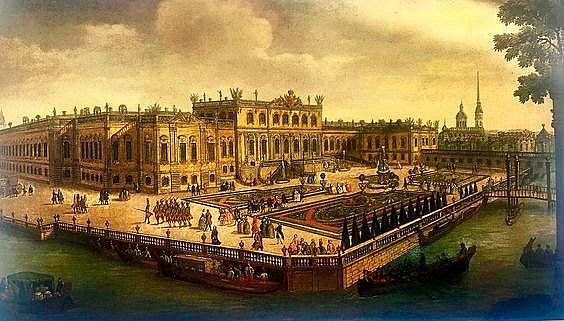 |
| A painting depicting the Peterhof Summer Palace during the 18th century, was created by an unidentified artist. (Photo: rusmuseumvrm.ru) |
The Grand Place now serves as a museum of history and art, drawing numerous tourists. To preserve the integrity of the valuable artworks and the regal surroundings, photography, and videography are prohibited inside the palace. This policy ensures that visitors can fully engage with and appreciate the direct, unique experience.
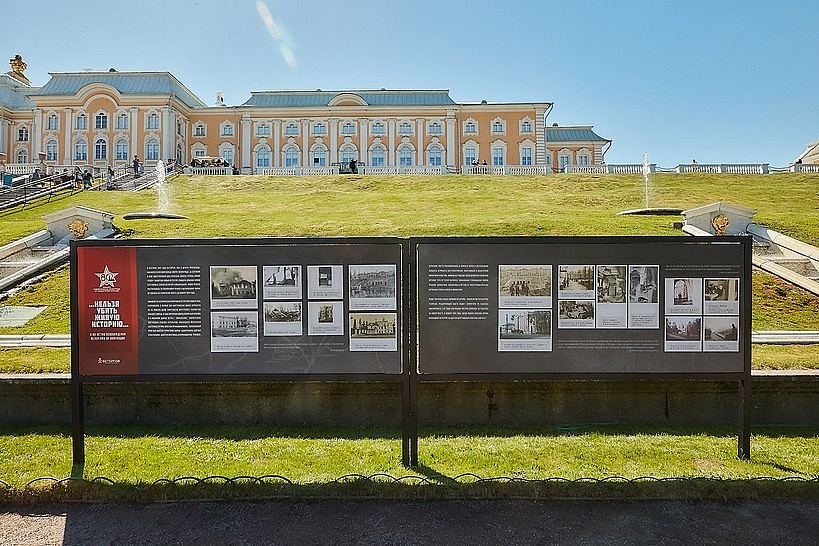 |
| The Grand Place is now used as a museum of history and art. (Photo: peterhofmuseum.ru) |
Peter the Great's Summer Residence
The concept of a grand summer palace on the outskirts, rivaling the splendor of France's Palace of Versailles, originated with Emperor Peter I (1672-1725) in 1714. Historical records indicate that Peter I took on the role of the primary architect for Peterhof. He aimed to manifest the full might of the nation through an impressive edifice, establishing a series of estates that were not just grandiose but also captivating and aesthetically pleasing.
The building was utilized annually from May to October, which is why it featured thin walls and single-layered glass windows appropriate for the summer weather. Notably, the palace's ventilation system, procured from Dresden, Germany, was powered by a wind engine and included a control panel that indicated wind direction and speed. Moreover, the palace was equipped with subterranean levels that housed drainage and waterproofing systems to shield it from the Gulf of Finland's climatic deterioration.
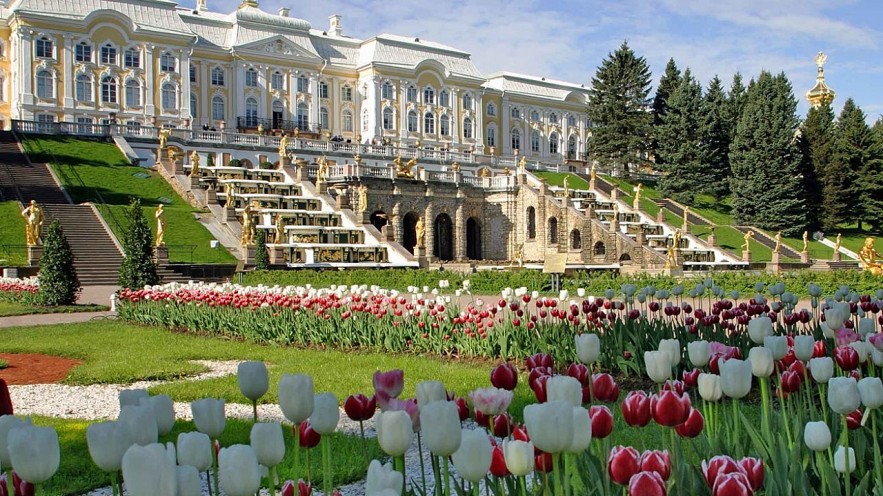 |
| Tulips in full bloom in front of the Summer Palace. (Photo: AT Travel) |
Peter the Great also focused on developing gardens around the palace. The fertile soil was transported to this area. Tulips, roses, cypresses, and other plants were imported from renowned European flower gardens. Additionally, exotic plants from distant regions like Siberia, Crimea, and the Caucasus were introduced to Peterhof. The expansive gardens, abundant with trees and an array of fountains, were designed not merely for ornamentation but also to serve a natural cooling function.
Furthermore, to accommodate the travel needs of the royal family and esteemed guests, a canal was constructed from the Gulf of Finland, enabling vessels to arrive directly at the castle's main entrance. The inauguration of the Peterhof Summer Palace was celebrated in August 1723.
Subsequent Tsars felt it was their responsibility to carry on the construction and refurbishment of Peterhof, each contributing their distinctive flair to the period. In Queen Elizabeth's time, between 1745 and 1755, the renowned architect Francesco Rastrelli redesigned and enlarged the palace. Despite substantially increasing the palace's dimensions, he preserved the distinctive architectural elements from Peter I's era, resulting in a 268-meter-long palace with a grand and imposing facade facing the Gulf of Finland.
From Royal Property to National Property
Peterhof has seen not only times of prosperity but also significant historical turmoil. The October Revolution in 1917 signified the end of the Russian monarchy and the rise of the Bolshevik government. This new authority proclaimed the royal estates, Peterhof Palace included, as state-owned, leading to significant shifts in the palace's administration and utilization.
In 1918, Peterhof Palace was opened to the public for the first time, marking a significant moment particularly for the working class. This event symbolized the deep transformations occurring within Russian society and politics. The grand chambers of the palace, once exclusive to nobility and royalty, became accessible to people from every social class.
During World War II, the palace sustained severe damage from the Nazi forces. The Upper and Lower Gardens were laced with mines, and numerous palaces and castles were detonated and set ablaze. The central palace suffered near-total destruction due to bombing and artillery fire, and the fountain system incurred significant damage.
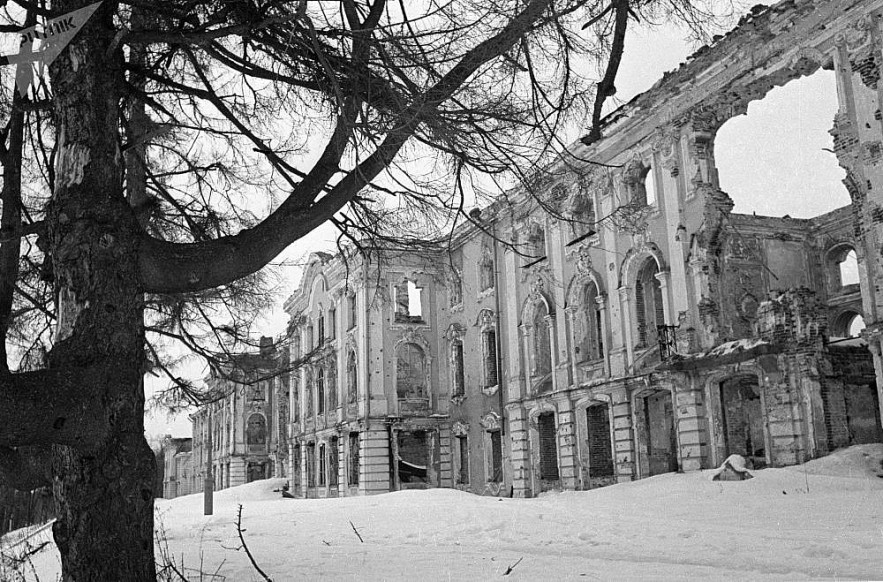 |
| The palace was heavily damaged by Nazi troops during World War II. |
Following its liberation in 1944, restoration efforts at Peterhof commenced promptly and continued for approximately 30 years. The palace and park complex were not fully restored to their former glory until 1973, preserving their significance as a vital cultural emblem of the nation. In 1990, the Peterhof Summer Palace was designated a World Heritage Site by UNESCO.
Numerous renovations have been undertaken to date, including the expansion of cafes, and souvenir shops, the addition of convenient walking paths, and the placement of directional signage to facilitate visitor navigation. Annually, Peterhof becomes the venue for several significant festivals, including "Peterhof Days," "Gardens and Fountains," and the Peterhof Music Festival, as well as art exhibitions and historical commemorations, drawing vast crowds of attendees.
Efforts to preserve and manage heritageAlthough Peterhof draws over 4 million visitors annually, it confronts numerous challenges. The severe Russian climate, characterized by cold, damp winters, renders materials like stone, wood, and metal vulnerable to deterioration. The significant temperature fluctuations across seasons contribute to the expansion and contraction of structures, resulting in cracks and cumulative damage. Additionally, the high humidity emanating from the fountains heightens the risk of mold and moss, which can harm architectural elements and ornamental features. Moreover, Peterhof is challenged with the preservation and development of sustainable tourism. Its extensive gardens are artistic masterpieces and also serve as habitats for diverse plant and animal species. Human activity, particularly at the height of the tourist season, can degrade these natural habitats. Managing tourist numbers is a significant challenge, as it involves safeguarding visitor safety and preserving historical heritage from harm.
Roman Kovrikov, the Director General of the Peterhof Museum, stated that the local government and palace administration have implemented numerous strategies to address this issue via extensive restoration initiatives. Specifically, they are concentrating on sustainable building materials and cutting-edge methods, including the reinforcement of wooden structures with composite materials, the replication of intricate decorative elements through 3D printing technology, and the enhancement of drainage systems with modern hydraulic techniques. To manage the influx of tourists during peak season, measures have been introduced to control visitor numbers. These include restricting the number of visitors within specific timeframes and creating designated tour routes.
Roman Kovrikov emphasizes the importance of preserving the ecosystem within the extensive gardens of Peterhof. Between 2020 and 2024, Peterhof has undertaken a project to restore trees and flowers in line with the original designs from the 18th century. These initiatives serve not only to preserve the historical landscape but also to support biodiversity. The newly planted trees offer a home for small animals like squirrels, rabbits, and beneficial insects, thus enhancing the garden's natural food web. Alongside conservation efforts, educating and increasing public awareness about the heritage's value is a crucial aspect of the Peterhof protection strategy. Local authorities frequently conduct educational programs, exhibitions, and community events to inspire both visitors and residents to appreciate the significance of safeguarding the cultural and historical values of the palace. |
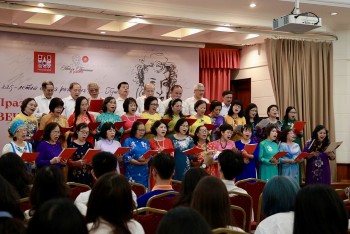 | Russia and Vietnam: Soulmates From Across Borders Russia has trained millions of students from all over the world, yet Vietnamese students have a special place in the hearts of Russian teacher. Most ... |
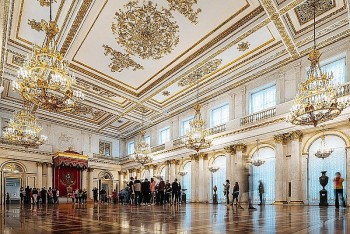 | Winter Palace - Architectural and Historical Masterpiece Situated at the core of Saint Petersburg, Russia's second-largest city, the Winter Palace stands as not just an architectural marvel but also a representation of ... |
In topics
 Viet's Home
Viet's Home
Translator Thuy Toan Lights the fire of love for Russian - Vietnamese literature
Recommended
 World
World
India strikes back at terrorists with Operation Sindoor
 World
World
India sending Holy Relics of Lord Buddha to Vietnam a special gesture, has generated tremendous spiritual faith: Kiren Rijiju
 World
World
Why the India-US Sonobuoy Co-Production Agreement Matters
 World
World
Vietnam’s 50-year Reunification Celebration Garners Argentine Press’s Attention
Popular article
 World
World
"Will continue offering our full support to Indian govt": US FBI Director after Pahalgam attack
 World
World
"Great Leader": JD Vance Lauds PM Modi During His India Visit
 World
World
Trump’s Tariff Pause: A Strategic Move from “The Art of the Deal”?
 World
World

